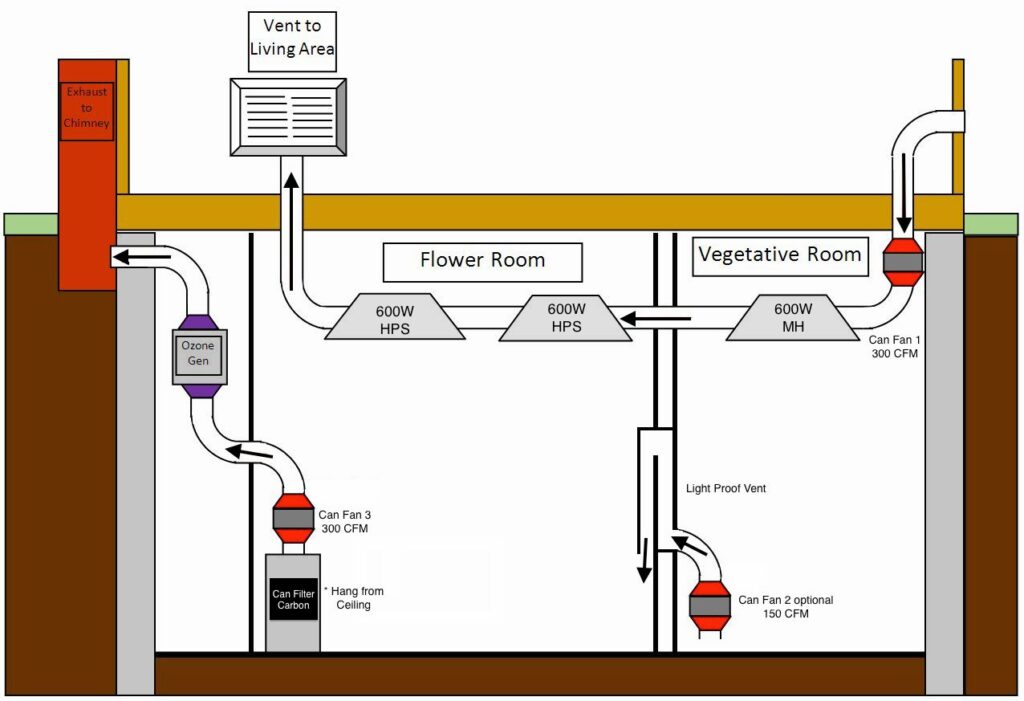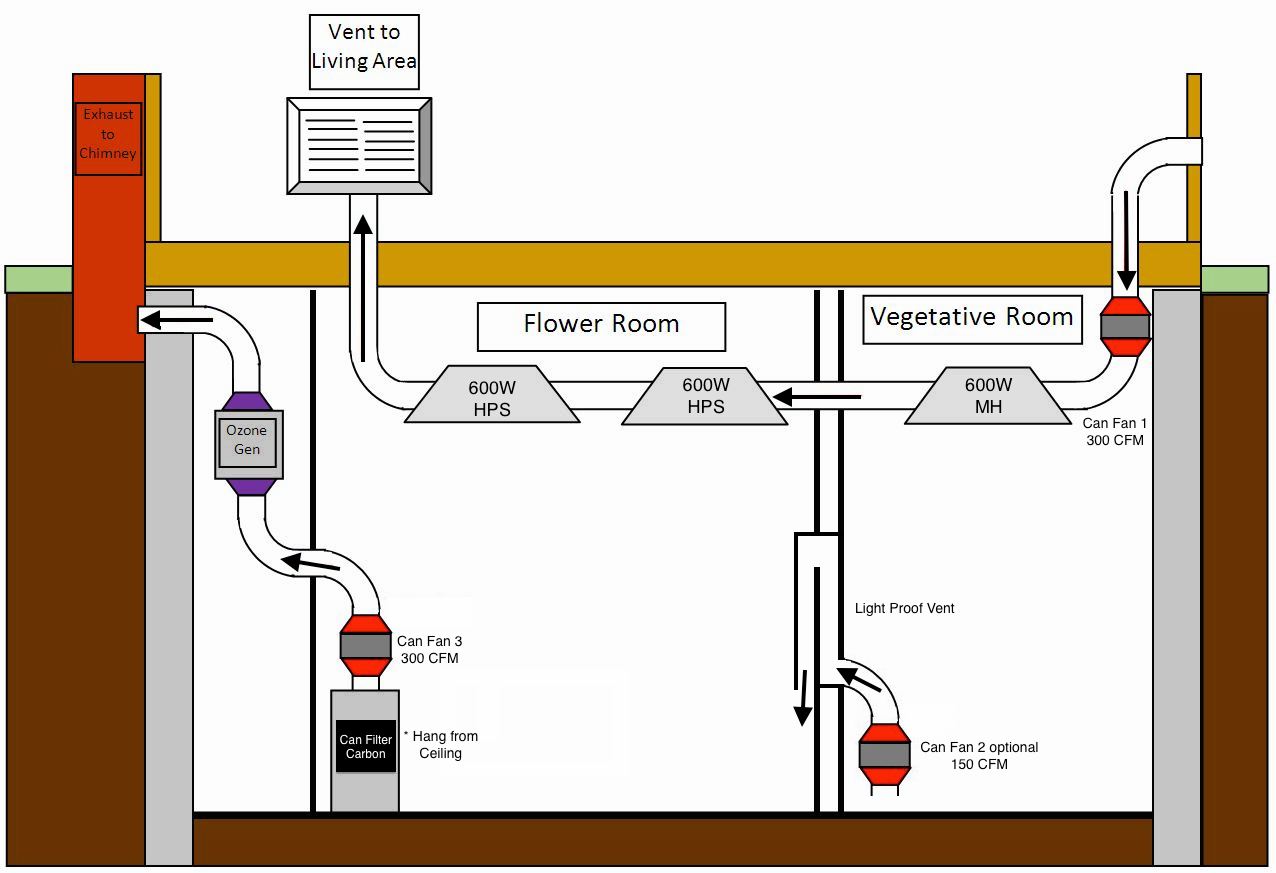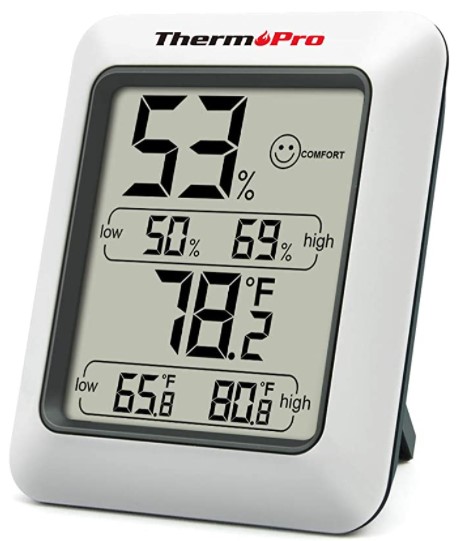Create the best climate for the cannabis grow room
Once you’ve decided to grow your cannabis plants indoors, your next step is to figure out exactly how you’re going to do it. There are a number of factors to consider when setting up your indoor growing environment.
Whether it’s the temperature or humidity of the room, the carbon dioxide levels, the ventilation, or the smell, you need to arrange everything perfectly so that you create the ideal environment for your marijuana plants.
Even if this seems very time-consuming at first, you will be rewarded with a better harvest in the end. Something you might regret afterward if you didn’t do enough research or preparation.
If you put some time and work into planning ahead, the result will be worth it. This article covers the following key elements for creating and maintaining an appropriate indoor cannabis growing environment.

Cannabis Grow Room Climate – Temperature
Although it can vary somewhat between different cannabis strains, the best temperature for marijuana is usually between 20-25 Celsius ( 68-77° Fahrenheit.)
If the ambient temperature around your cannabis plants drops below these ideal temperatures, the plant’s growth will slow down. This can affect potential yields and new growth may possibly be stunted or even stopped completely.
This ideal temperature is most important during a “day” cycle when the plants are getting light. That’s when photosynthesis and growth potential occur. However, you should avoid large temperature fluctuations between day and night if you can avoid them.
When your cannabis plant‘s temperature rises above 25°C ( 77° Fahrenheit.), metabolism speeds up and additional resources are needed: more light, more water, more carbon dioxide, and more fertilizer.
It’s wise to invest not only in a regular room thermometer but also in a thermometer that connects to your ventilation and heating system so that it can automatically regulate the temperature of your grow room. A working automatic ventilation system can also provide you with excellent ventilation for fresh air and avoid carbon dioxide starvation.
Cannabis Grow Room Climate – Humidity
The ideal humidity around the cannabis plant is between 40-70%.
To measure humidity, you need a hygrometer. Although any device that measures humidity will work, an electric hygrometer is probably a better choice for most growers.
It’s more precise and often has an automatic feature that gives you some level of control over humidity, which is always good for indoor growing.
If your plant’s humidity drops below 40%, then the plant will experience a faster rate of transpiration. This shouldn’t be a big concern. It will simply cause your plant to use water at a higher rate. As long as there is enough water in the soil, you won’t have any problems.
On the other end of the spectrum, if humidity levels are too high, you put the plant at risk of mold (fungus) growth, especially during flowering, when buds can rot very quickly.
You’ll almost certainly want to have a dehumidifier on hand if you don’t have an automatic one installed so you can troubleshoot moisture problems as they arise.
Cannabis Grow Room Climate – Carbon Dioxide
Carbon dioxide is a fundamental element of photosynthesis and one of the most important building blocks for the functioning of plants.
In nature, the air will naturally contain a lot of carbon dioxide, and the plants are automatically and constantly supplied with 300-400 ppm CO2 in the atmosphere.
Your plants use up carbon dioxide very quickly, something to watch out for when working in a closed-room system. If there is too little carbon dioxide for a plant, photosynthesis will not take place and a plant will not grow.
The volume and ratio of carbon dioxide in the environment of your indoor grow area (grow room) is also something that benefits from a well-controlled exhaust and ventilation system. CO2 is denser and heavier than oxygen, so a fan will mix it up and make sure it reaches your plants.
Remember that if you are not introducing additional carbon dioxide directly to your plants (grow area), you must ensure that you keep the extractor and ventilation running the entire time you have the lights on. Photosynthesis consumes carbon dioxide very quickly!
Increasing C02
You can increase the level of CO2 in the air to increase the plant’s metabolism, up to 1500 ppm of CO2. If you increase the CO2 then keep the temperature stable between 25-30 degrees Celsius. That also means you should increase the humidity from 40% to ~60% (keep an eye on that, that’s pretty humid).
You will also need to provide supplemental fertilizer with increased CO2. If you manage all of these factors extremely carefully, you will get a significantly higher yield within the same growing time, but you will have to put in a little extra work.
If you want a strong cannabis plant with very tight internodes and buds and a quick harvest, chances are you’ll want to add CO2. Beware, however, this technique is very difficult, so only experienced growers should attempt it.
Once you know what you’re doing, you can give it a try to save a little time growing. Remember to be careful with the addition of CO2 because although plants benefit from it, it can make the air uncomfortable for humans. In addition, it is unfortunately quite difficult to measure.
You can measure the CO2 levels, but the necessary equipment is very costly. Although it is a chemical process, it is a one-time test. The measurement involves a glass tube divided into degrees and a syringe.
Cannabis absorbs carbon dioxide and exhales oxygen through the stoma in the leaves. Without enough fresh air, this stoma will eventually close and the plant itself will die. Not so dissimilar to what happens when there is no fresh air for humans.
Make sure you have a good ventilation and exhaust system, whatever it is, and how you set it up. It helps you manage many different facets of growth.
Cannabis Grow Room Climate – Ventilation and Airflow
Proper ventilation and movement of air in a space can be difficult to fully control, but providing the right nutrients, light, and water is just as important.
Proper airflow ensures stable humidity, temperature, and CO2 levels and also controls the aromatic nature of an indoor grow room.
When you grow indoors, you want the best possible environment for your plant. In a natural environment, you have wind as a natural source to strengthen your cannabis plant’s structural integrity and rain to keep it free of dust and pesky parasites. Try to create this type of environment to the best of your ability.
Make sure your fans are in different places in your grow room because you want to move all the air around, not just the air in one section of the room. You get the best results when you maximize the efficiency of your air handling units.
In general, two fans should face each other in a room and the ventilation system should be installed in a completely different place. This type of setup creates a more stable atmosphere in the room, helping to balance carbon dioxide levels, humidity, and temperature.
If you are struggling with too much humidity in your grow room, consider having the fans pointing toward the ceiling. In this way, you inhibit the factors caused by moisture. Another option is to hang fans at the same height as your grow lights. This will blow the hot air around the lights out of the room and lower the temperature inside your grow light.
Checking the temperature
It’s best when your cannabis plants get plenty of fresh air and especially good when they get enough CO2 as well.
The easiest way to achieve this is to run the exhaust system all day. However, this method can also cause problems.
Outside air isn’t necessarily the right temperature for your plants, especially if you’re growing at a latitude that experiences winter (which many indoor growers do), or if you simply have cold nights.
Although a cannabis plant is tough, it is still a warm-weather plant.
Other problems can also arise if the humidity in the outside air that you circulate through your grow room is too low. Air that is too dry can damage a plant and stunt development.
Luckily, all of these problems are solved by setting up an automated system that allows you greater and more precise control over the indoor climate of your grow room.
This thermostat is a device that regulates the temperature by turning the system on and off automatically. You may already be familiar with this device. What you need to do is set the right temperature for your grow room.
If you connect a controller with a thermostat to the ventilation system, it can turn on the suction when it gets too hot. Or turn it off when it’s too cold. The device can also be connected to central heating, a radiator, or an air conditioner.
Checking the humidity
Use an automatic moisture meter to check the humidity. This works in the same way as the thermostat. You can connect it to the ventilation system and have it turn on or off based on the amount of moisture present.
One problem with such a setup is that if the exhaust system goes haywire, the room will not be refreshed with carbon dioxide. Then it would be like working without an air conditioning system, right?
The automatic humidity meter can even be connected to a humidifier or dehumidifier, which will fine-tune the humidity in your grow room.
Camouflage your Grow
As an indoor grower, you should consider discretion. One of the great things that will help keep your grow room private is to manage smell.
In addition to smell, however, there are a few simple steps you should take to camouflage the grow room.
First and foremost, you’re going to want something that will somewhat hide the exhaust vent you have outside without interfering with its functionality.
You can use plants, pieces of plastic, or these fun faux rocks. Use your imagination!
Another tip is to find any vibrating (rattling) spots and cover them with silicone or plastic. This way you minimize loud vibrations or rattling from all the fans and motors.
Also, check different ventilation systems or ask before you buy. Some are noticeably louder than others. It can be helpful to get some guidance from the seller or someone with personal experience.
Control the smell
There’s a reason people refer to the cannabis plant as “Skunky”. Especially in the flowering phase, it has an extremely strong smell. It can get very intense.
Your ventilation system will obviously take care of this and push the smell out of the grow room for you. But not so fast, here’s something crucial to consider. Simply pushing the smell away from the grow room is not effective. You don’t want to have an intensely scented cloud of cannabis around your living area.
To not only remove this odor but to neutralize it, you can use an odor filter. Usually, some sort of carbon-binding device traps the odor molecules within.
There are a number of different options for this type of device. These work much better than trying to mask the air with another strong scent.
Most odor filters are metal cylinders with a carbon filter inside. The filters are located near the exhaust fans, so the air is clean when it leaves the grow area.
Use cotton to make the carbon filter last longer. Wrap the cotton around the cylinder – it will filter out extra dust particles. This extends the life of your filter. However, you still need to replace the filter every 30-40 weeks to ensure proper functioning.






